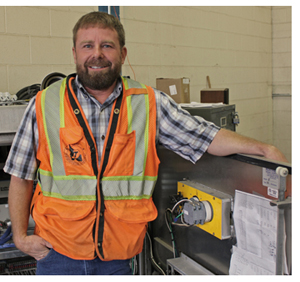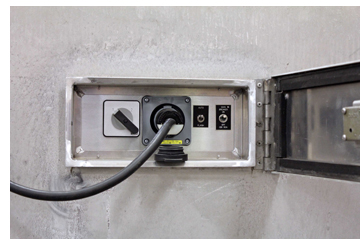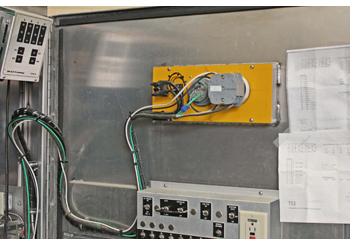
Small investment improves safety, mobility at signals
during power outages
The power goes out, a traffic signal is down. There could be a dozen different reasons why the power is out, but if a battery backup system isn’t in place, then frustrated traffic is left to negotiate the intersection as a four-way stop.
In many cases, when a signal is off due to power failure, traffic control from law enforcement or ITD personnel is required until power is restored. Some signals, primarily those at major intersections or along high-speed routes, are already outfitted with a costly battery-powered backup system, but the majority of signals are left dark in such times.
Idaho Transportation Department electrician Robin Hite (pictured left), from the District 4 area in Shoshone, developed an idea to help bring these signals back online as soon as possible by using a service truck to power the signal.
“We pull up to the signal, the (power) is down and the signal is black, and within about three minutes we can put this thing back online,” Hite said.
This has been possible due to power-saving technology being installed in all signals. In recent years, ITD has been upgrading aging signals and installing power-efficient LED lights.
“In the process of upgrading all the traffic signals to LEDs, we were able to bring the power consumption down drastically,” he added.
The older signals, with the original incandescent bulbs, required 50-amp switches to supply enough power, but the LED lights pull as little as three amps of power during normal operation. With less power to operate, it became viable to use an alternate power source when the power was down.
District 4 installed power inverters in three service trucks, which can be deployed when necessary. Currently, 11 signal-control cabinets have been outfitted with the transfer switch and power plugin to supply temporary power to the signal control cabinet.
This solution can be installed or retrofitted into other signal control cabinets for as little as $200 and two hours of labor. With more than 50 signals in District 4 without battery backup, the total cost to outfit with the plugin option will only be about $10,000. To reduce the cost even more, Hite started utilizing scrapped aluminum road signs for the switch panels and guards.
Pictured left is the inside power plug-in, and right is the outside plug-in.

In contrast, the costly battery backup system is about $5,000 per installation with regular maintenance and battery upgrades necessary. To outfit all signals in District 4 with the battery system would cost nearly $300,000.
“We’re not having the flaggers out there, we’re not having to set up stop signs,” Hite said. “We’re not having to invest $5,000 in a (battery) system.
“It’s a simple install that doesn’t take a lot and you can outfit 50 signals if you have to,” Hite added. “Not much to it, it’s pretty basic.”
The goal is to upgrade 5-10 existing signal cabinets per year as well as install the system with new signals or during upgrade projects.
Times 7 Focus: Ideally, these innovations will not live in a silo — they will be catalysts for ITD’s other district offices and work areas, and inspire duplication statewide. These innovations represent time and money-saving measures, process improvements, and customer-service efficiencies that are transferrable to other districts. In that spirit, if this innovation is something you’d like to adapt to your own district or work space, and you have any questions, please contact District 4's Robin Hite at 4-7875.
Published 09-02-16